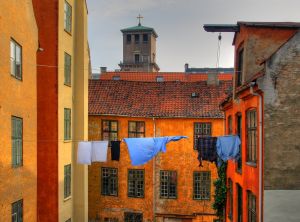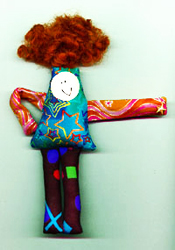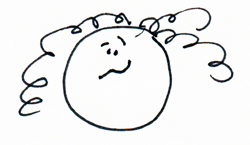Product links support this website. Details.
Should you preshrink fabrics (or even prewash them) before making a cloth doll?

Yes… and no. It depends upon what’s important to you.
It also depends upon whether the doll is for display, as art, or if you (or someone else) will play with the doll.
Why not to prewash or preshrink fabrics
Fabrics, especially cottons, never look quite so “fresh” after prewashing.
The sizing* and surface finish wash off, so the fabric doesn’t look as smooth. In most cases, you’ll never wash the doll in a machine anyway, so why worry about shrinkage?
Also, not preshrinking fabric saves you considerable time since you won’t be ironing it.
You can rush home with your new fabrics and head straight to the cutting table. That’s ideal if you have amazingly creative visions in your head and can’t wait to turn them into a doll or two or three!
Dolls seem to turn out best when the full energy of your brilliant concept is right there, fresh in your mind.
Pausing to do anything mundane, such as washing & drying, can be lethal to that fresh & vital energy.
In other words: You don’t have time to preshrink fabrics. Just get to work and create that doll!
Yes, the fresh-from-the-store surface treatment may repel inks and paints when you’re adding details (such as the face). That’s easy to fix. Add a couple of drops of a surfactant** to your painting water, to break down the resistance. Prewashing is not necessary.
Why you should prewash or preshrink fabrics
When fabrics have been treated with sizing and a surface finish, they often won’t accept paint, pen, and/or felt marker designs. If you’re adding a lot of artwork to the surface of your doll, prewashing solves that problem.
If the doll has an accident — like when something spills on her — you can wash her (carefully, of course) without worrying about the results. Prewashed fabrics have already shrunk, bled, puckered, and softened as much as they’re likely to.
If you always preshrink fabrics as soon as you bring them home, you can confidently use the same fabric in your wearable art and know that the finished garment can be tossed into the washing machine.
How I preshrink fabrics
First, I trim any loose threads off the fabric. They’ll fray in the laundry. Sometimes, those loose threads can wrap the fabric into a tight, wrinkled ball by the time the drying is completed.
If it’s a small and expensive piece of fabric, I may fray-check the cut edges to prevent further unraveling and fraying.
Dritz makes a product called “Fray Check” for this. Other manufacturers have similar products. I always use the Dritz product; it can be a lifesaver.
Before prewashing, I refold the fabric so it is not folded along the same line as it was on the bolt.
If you don’t do that, the original fold line might promptly wear and fade, even in the first washing. You’ll have to cut around that part of the fabric.
I always wash the fabric by itself, or in the laundry with dark items that will not bleed.
(“Bleeding” colors mean colors that aren’t permanently dyed. In that case, some of the color may wash out during the first washing, and sometimes during successive laundering. )
For example, my kitchen dishtowels don’t show stains, so they can be thrown into the same washload with fabrics I’m preshrinking.
Three things can happen when you preshrink fabrics
 First, there’s the effect of water on the fabric.
First, there’s the effect of water on the fabric.
Some fabrics pucker, wrinkle, and go limp in water.
Puckering and wrinkling can be steamed out when you iron. The limpness is resolved with spray sizing or starch, usually added when you iron. (
I haven’t tried this product yet, but I’ve heard it’s the best option for restoring the “new” look to fabric: London Laundry’s Spray Starch Alternative. Let me know if you try it and like it.)
 IMPORTANT: if you’re going to paint or draw on the fabric, it’s best to apply the sizing or starch after you paint or draw, so the pigment is well absorbed. (That’s important.)
IMPORTANT: if you’re going to paint or draw on the fabric, it’s best to apply the sizing or starch after you paint or draw, so the pigment is well absorbed. (That’s important.)
Next, consider the effect of soap and water on the fabric.
The colors may run as you preshrink fabrics. The texture of the fabric may change, too.
Almost anything can happen, particularly if you’ve bought cotton from an unknown manufacturer, or mixed-fiber fabric from the markdown bin.
I use cold water the first time I wash a fabric. Some people also add a small amount of vinegar or salt to the water to set the colors.
You can also use one of those disposable towels that absorb excess (“bleeding”) colors in the washing machine.
Sometimes, as I mentioned earlier, texture changes can be remedied with plenty of steam ironing and starch or sizing.
However, some fabrics will never look the same as when they were new, which is why some dollmakers prefer not to prewash.
Finally, there’s the effect of dryer heat. I use the hottest dryer setting and dry the fabric for over an hour, usually tossing in other loads of laundry rather than wasting dryer heat on just one piece of fabric.
(Exposure to dryer heat can be the most important step when you preshrink fabrics.)
In my experience, shrinkage is not eliminated until the fabric has been through two to three hours of dryer heat.
A Quick Review
If you love the fabric just as you bought it, and you don’t plan to wash your cloth doll, ever, there’s no reason to preshrink fabrics.
However, if your doll may be exposed to wear & tear, and stains or dirt are possible, preshrinking can reduce worries.
Fabrics can change color, size and texture in the laundry and dryer. In some cases, you can restore the texture. Faded colors and shrinkage usually cannot be reversed.
I preshrink almost all of my fabrics before using them in dolls, but there are exceptions when the doll will be displayed, not worn (as a pin doll) or played with.
** Surfactant: A product which breaks the surface tension of water, and helps “cut through” the protective layers sometimes applied to stain-resistant (and other) fabrics.
I use a Shaklee product called Basic H, and place two or three drops in a pint of water when I’m using watercolors on a doll, if the paint beads too much. But, you can do the same thing with a drop of dishwashing liquid. (That is, liquid soap intended for washing dishes by hand.)
My advice: Carefully consider every reason to preshrink fabrics (or not to) before beginning to work on your cloth dolls and figures.
Amazon and the Amazon logo are trademarks of Amazon.com, Inc, or its affiliates. As an author and affiliate, I may earn a small commission if you purchase anything through my links. That does not affect the item's price, and I only link to products that I use and like, myself.

Thank you for this (and the article on buying good quality stuffing) I usually pre-wash if it’s cotton as I really dislike the feeling of stiff new fabric, and I always hand wash silk dupion and iron it while damp. So much dye comes of the dupion that I can dye Easter Eggs in it.
However, you’re absolutely right about going with the flow if you have inspiration, because it can be difficult to get back once it’s gone.